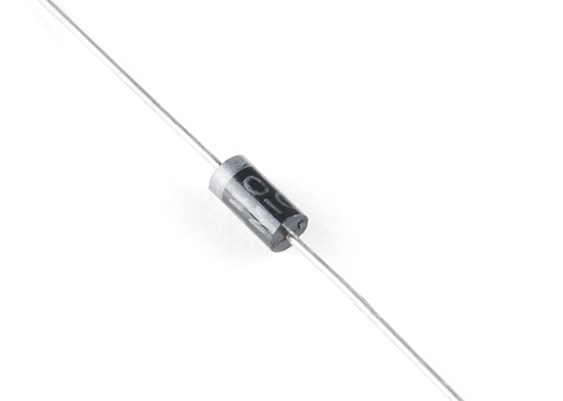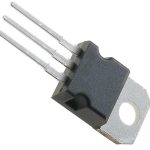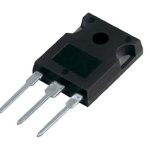The 1N4004 diode is a versatile electronic component that plays a crucial role in rectifying electrical currents. With its ability to convert alternating current into direct current, it finds numerous applications across different industries. In this blog, we will delve into the features, uses, and applications of the 1N4004 diode, exploring its significance in various electronic circuits.
What is 1N4004 diode?
The 1N4004 diode is a popular rectifier diode that belongs to the 1N400x series of diodes. It is a silicon diode designed for general-purpose rectification applications. Diodes are electronic components that allow current to flow in only one direction, acting as one-way valves for electric current. The 1N4004 diode specifically offers a maximum forward current of 1A and a peak reverse voltage of 400V.
Features of 1N4004
- Forward current (If): The maximum continuous forward current that the diode can handle without getting damaged. For 1N4004, it is 1A.
- Peak reverse voltage (PRV): The maximum voltage that the diode can withstand when applied in the reverse bias configuration. 1N4004 has a PRV of 400V.
- Forward voltage drop (VF): The voltage drop across the diode when conducting forward current. Typically, it is around 0.7V for the 1N4004 diode.
- Reverse recovery time (trr): The time required for the diode to transition from forward conduction to reverse blocking when the voltage polarity changes. The 1N4004 diode has a relatively low reverse recovery time, making it suitable for high-frequency applications.
Specs
| Product Attribute | Attribute Value |
|---|---|
| Diodes Incorporated | |
| Product Category | Rectifiers |
| 400 V | |
| 1 A | |
| Standard Recovery Rectifiers | |
| Single | |
| 1 V | |
| 30 A | |
| 5 uA | |
| 2 us | |
| – 65 C | |
| + 175 C | |
| 1N400 | |
| Reel | |
| Cut Tape | |
| Brand | Diodes Incorporated |
| Height | 2.71 mm |
| Length | 4.7 mm |
| Product | Rectifiers |
| Product Type | Rectifiers |
| Subcategory | Diodes & Rectifiers |
| Termination Style | Through Hole |
| Width | 2.71 mm |
| Unit Weight | 0.012346 oz |
Pin Out

PCB symbol and Footprint


Datasheet
Download 1N4004 pdf document here right now!
Applications
Some common applications of the 1N4004 diode are:
- Power supply circuits: It is widely used in power supplies to rectify AC voltage and provide DC power for various electronic devices.
- Battery chargers: The diode can be found in battery charging circuits where it converts alternating current from the charger into direct current for charging batteries.
- Half-wave rectifiers: The 1N4004 diode is commonly used in half-wave rectifier circuits, where it allows only one-half of the input AC waveform to pass through.
- Voltage regulators: It can be utilized as part of voltage regulator circuits to stabilize and control output voltages.
What is the difference between 1N4004 and 1N4007?
The main difference between the 1N4004 and 1N4007 diodes lies in their voltage ratings. While both are rectifier diodes, the 1N4004 has a maximum peak reverse voltage (PRV) of 400V, whereas the 1N4007 has a higher PRV of 1000V. This means that the 1N4007 can handle higher voltage levels compared to the 1N4004, making it suitable for applications requiring greater voltage tolerance.
What is the difference between 1N4001 and 1N4004?
The key difference between the 1N4001 and 1N4004 diodes is also related to their voltage ratings. The 1N4001 has a PRV of 50V, whereas the 1N4004 has a PRV of 400V. This means that the 1N4004 can handle significantly higher voltage levels than the 1N4001. Therefore, if your application requires higher voltage tolerance, it is recommended to use the 1N4004 diode instead of the 1N4001.
How to use 1N4004 diode?
The 1N4004 diode is a popular general-purpose rectifier diode that is widely used in various electronic circuits. Here’s a step-by-step guide on how to use the 1N4004 diode effectively:
1. Identify the diode
The 1N4004 diode has a cylindrical shape with two leads, an anode (positive) and a cathode (negative). The cathode side is typically marked with a band or stripe.
2. Determine the polarity
As a rectifier diode, the 1N4004 allows current to flow in one direction while blocking it in the opposite direction. The side with the marking or stripe is the cathode (negative), and the other side is the anode (positive).
3. Connect the diode in a circuit
The most common application of the 1N4004 diode is in rectifier circuits, where it converts alternating current (AC) to direct current (DC). In this application, connect the anode of the diode to the positive terminal of the AC input source and the cathode to the load or output. Ensure the diode is connected with the correct polarity, otherwise, it may not function properly.
4. Consider using additional components
Depending on your specific circuit requirements, you might need to include other components such as resistors, capacitors, or voltage regulators along with the 1N4004 diode. These additional components can enhance the functionality and protection of your circuit.
5. Test and troubleshoot
Once the 1N4004 diode is properly connected in your circuit, test the circuit’s performance under different conditions. If you encounter any issues or unexpected behavior, double-check the diode’s connections, polarity, and compatibility with the circuit.
Remember, safety is important when working with electronic components. Before connecting or disconnecting the diode, ensure that the circuit is not powered and take necessary precautions to prevent accidental electrical shocks or damage to the components.

FAQs
What is the current of 1N4004?
The 1N4004 diode has a maximum forward current (If) rating of 1A. This means that it can safely carry a continuous current of up to 1A without getting damaged. However, it’s always recommended to consider derating factors and operate the diode within its specified limits to ensure reliability and longevity.
What is equivalent to 1N4004 diode?
Several diodes are considered equivalents to the 1N4004. Some common alternatives include the 1N4001, 1N4002, 1N4003, 1N4005, 1N4006, and 1N4007. These diodes belong to the same 1N400x series and have similar characteristics, but they differ in their peak reverse voltage ratings. Depending on the specific voltage requirements of your application, you can choose the diode that best suits your needs from this series.
Can I use 1N4004 instead of 1N4001?
Yes, you can use a 1N4004 diode instead of a 1N4001 diode, provided that the voltage requirements of your circuit are within the range supported by the 1N4004 diode. The 1N4004 has a higher peak reverse voltage (PRV) rating than the 1N4001, making it suitable for applications that require greater voltage tolerance.
However, it’s important to ensure that the rest of the circuit components can handle the increased voltage levels as well. Always refer to the datasheets and specifications of the diodes to make an informed decision.
Conclusion
The 1N4004 diode stands as a fundamental building block for rectification and voltage regulation purposes. Its reliable performance, along with its affordable price and wide availability, makes it a popular choice among engineers and hobbyists alike. By understanding its characteristics and applications, we can harness the power of this diode to enhance the efficiency and functionality of our electronic designs.



